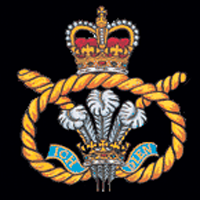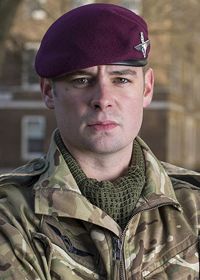Bryan James Budd VC 3rd Battalion, the Parachute Regiment (3 PARA)

First cited incident
In the first incident, On 27 July 2006, whilst on a routine patrol, Corporal Bryan Budd's section identified and engaged two enemy gunmen on the roof of a building in the centre of Sangin. During the ensuing fierce fire-fight, two of Corporal Budd's section were hit. One was seriously injured and collapsed in the open ground, where he remained exposed to enemy fire, with rounds striking the ground around him. Corporal Budd realised that he needed to regain the initiative and that the enemy needed to be driven back so that the casualty could be evacuated.
Under fire, he personally led the attack on the building where the enemy fire was heaviest, forcing the remaining fighters to flee across an open field where they were successfully engaged. This courageous and prompt action proved decisive in breaking the enemy and was undertaken at great personal risk. Corporal Budd's decisive leadership and conspicuous gallantry allowed his wounded colleague to be evacuated to safety where he subsequently received life-saving treatment.
On 20 August 2006, A Company, 3 PARA was located in the southern Afghanistan town of Sangin. Cpl Budd and his platoon were ordered to hold a small, isolated coalition outpost - dubbed a platoon house - to protect engineers blowing holes in a compound 500 metres away. The site was subject to almost daily Taliban onslaught for months.
On the day, there were three sections on patrol, a total of 24 men, spread out in a head-high cornfield around the compound. Budd spotted four Taliban approaching, at a distance of 50 metres. With hand signals, Budd led his section in a flanking manoeuvre round to the cornfield's outskirts to try to cut them off, but they were spotted and the Taliban opened fire on the troops. A further group of Taliban opened up fire from a wall further back. The British soldiers took heavy fire, kneeling or lying down trying to take cover. One soldier received a bullet in the shoulder, and another was shot in the nose.
Realising his section were taking heavy fire and were likely to be killed, Budd got up and rushed straight through the corn in the direction of the Taliban, now just 20 metres away. Budd opened up on them in fully automatic mode with his rifle, and contact was immediately lost, but the Taliban fire lessened and allowed the rest of his section to withdraw back to safety so the casualties could be treated.
After withdrawal, Budd was declared missing in action and most of A Company was sent back to find him. Apache and Harrier air support was called in to beat the Taliban back. An hour later, Budd was found beside three dead Taliban.
Read more
|
|
| |
|
| |
|
Ian John McKay VC 3rd Battalion, The Parachute Regiment (3 PARA)

Citation
During the night of 11th/12th June 1982, 3rd Battalion The Parachute Regiment mounted a silent night attack on an enemy battalion position on Mount Longdon, an important objective in the battle for Port Stanley in the Falkland Islands. Sergeant McKay was platoon sergeant of 4 Platoon, B Company, which, after the initial objective had been secured, was ordered to clear the Northern side of the long East/West ridge feature, held by the enemy in depth, with strong, mutually-supporting positions. By now the enemy were fully alert, and resisting fiercely. As 4 Platoon's advance continued it came under increasingly heavy fire from a number of well-sited enemy machine gun positions on the ridge, and received casualties. Realising that no further advance was possible the Platoon Commander ordered the Platoon to move from its exposed position to seek shelter among the rocks of the ridge itself. Here it met up with part of 5 Platoon.
The enemy fire was still both heavy and accurate, and the position of the platoons was becoming increasingly hazardous. Taking Sergeant McKay, a Corporal and a few others, and covered by supporting machine gun fire, the Platoon Commander moved forward to reconnoitre the enemy positions but was hit by a bullet in the leg, and command devolved upon Sergeant McKay.
It was clear that instant action was needed if the advance was not to falter and increasing casualties to ensue. Sergeant McKay decided to convert this reconnaissance into an attack in order to eliminate the enemy positions. He was in no doubt of the strength and deployment of the enemy as he undertook this attack. He issued orders, and taking three men with him, broke cover and charged the enemy position.
The assault was met by a hail of fire. The Corporal was seriously wounded, a Private killed and another wounded. Despite these losses Sergeant McKay, with complete disregard for his own safety, continued to charge the enemy position alone. On reaching it he despatched the enemy with grenades, thereby relieving the position of beleaguered 4 and 5 Platoons, who were now able to redeploy with relative safety. Sergeant McKay, however, was killed at the moment of victory, his body falling on the bunker.
Without doubt Sergeant McKay's action retrieved a most dangerous situation and was instrumental in ensuring the success of the attack. His was a coolly calculated act, the dangers of which must have been all too apparent to him beforehand. Undeterred he performed with outstanding selflessness, perseverance and courage.
With a complete disregard for his own safety, he displayed courage and leadership of the highest order, and was an inspiration to all those around him.
Read more
|
|
| |
|
Lieutenant-Colonel Herbert Jones, VC, OBE 2 Battalion, Parachute Regiment (2 PARA)
.JPG)
Citation
On 28th May 1982, Lieutenant Colonel Jones was commanding 2nd Battalion The Parachute Regiment on operations on the Falklands Islands. The Battalion was ordered to attack enemy positions in and around the settlements of Darwin and Goose Green.
During the attack against an enemy who was well dug in with mutually supporting positions sited in depth, the Battalion was held up just South of Darwin by a particularly well-prepared and resilient enemy position of at least eleven trenches on an important ridge. A number of casualties were received. In order to read the battle fully and to ensure that the momentum of his attack was not lost, Colonel Jones took forward his reconnaissance party to the foot of a re-entrant which a section of his Battalion had just secured. Despite persistent heavy and accurate fire the reconnaissance party gained the top of the re-entrant at approximately the same height as the enemy positions. However, these had been well prepared and continued to pour effective fire onto the Battalion advance, which, by now held up for over an hour and under increasingly heavy artillery fire, was in danger of faltering.
In his effort to gain a good viewpoint Colonel Jones was now at the very front of his Battalion. It was clear to him that desperate measures were needed in order to overcome the enemy position and rekindle the attack, and that unless these measures were taken promptly the Battalion would sustain increasing casualties and the attack perhaps fail. It was time for personal leadership and action. Colonel Jones immediately seized a sub-machine gun, and, calling on those around him and with total disregard for his own safety, charged the nearest enemy position. This action exposed him to fire from a number of trenches. As he charged up a short slope at the enemy position he was seen to fall and roll backward downhill. He immediately picked himself up, and again charged the enemy trench, firing his sub-machine gun and seemingly oblivious to the intense fire directed at him. He was hit by fire from another trench which he outflanked, and fell dying only a few feet from the enemy he had assaulted. A short time later a company of the Battalion attacked the enemy who quickly surrendered. The devistating display of courage by Colonel Jones had completely undermined their will to fight further.
Thereafter, the momentum of the attack was rapidly regained, Darwin and Goose Green were liberated, and the Battalion released the local inhabitants unharmed and forced the surrender of some 1,200 of the enemy.
The achievements of 2nd Battalion The Parachute Regiment at Darwin and Goose Green set the tone for the subsequent land victory on the Falklands. They achieved such a moral superiority over the enemy in this first battle that, despite the advantages of numbers and selection of battle-ground, they never thereafter doubted either the superior fighting qualities of the British troops, or their own inevitable defeat.
This was an action of the utmost gallantry by a Commanding Officer whose dashing leadership and courage throughout the battle were an inspiration to all about him.
Read more
|
|
| |
|
Captain Queripel VC served in the 10th Battalion, Parachute Regiment, 4th Parachute Brigade, 1st Airborne Division
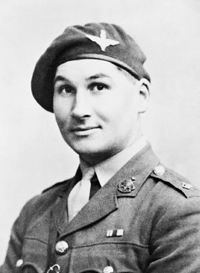
Citation
By 1400 hrs on 19th of September the confusion and heavy casualties saw Captain Queripel acting as commander of a company composed of the men of three parachute battalions. As they advanced along a main road on an embankment towards Arnhem they came under continuous machine-gun fire. At one point, the fire became so heavy that the company was split up on either side of the road and suffered considerable losses. Captain Queripel immediately began to reorganise his troops, crossing and recrossing the road while doing so, under extremely heavy and accurate fire from a strong point consisting of a captured British anti-tank gun and two machine guns. Whilst carrying a wounded sergeant to the regimental aid post under fire he was himself wounded in the face.
Having reorganised his force, Captain Queripel personally led a party of men against the strong point holding up the advance. Despite the extremely heavy fire directed at him, Captain Queripel succeeded in killing the crews of the machine-guns and recapturing the anti-tank gun enabling the advance to continue.
Later Captain Queripel was ordered to defend some woodland near the Wolfheze level crossing which was vital to the allied advance (Wolfheze is about 12km to the northwest of Arnhem Bridge but only a few hundred metres from the Drop and Landing Zones used). By this time he had received further wounds in both arms, was cut off with a small party of men and took up a position in a ditch. Disregarding his injuries and the heavy mortar and machine gun fire, he continued to inspire his men to resist with hand grenades, pistols, and the few remaining rifles. On at least one occasion he picked up and threw back an enemy stick grenade which had landed in the ditch. As the enemy pressure increased, Captain Queripel decided that it was impossible to hold the position any longer and ordered the men to withdraw. Despite their protests, he insisted on remaining behind to cover their withdrawal with his automatic pistol and a few remaining hand grenades. This was the last occasion on which he was seen.
Read more
|
|
| |
|
Lieutenant John Hollington Grayburn VC (149002), Parachute Regiment, Army Air Corps

Citation
Major Tatham-Warter was able to escape German captivity and later led nearly 140 men to safety in Operation Pegasus.
Upon his return to England he wrote a report on the action at the bridge, which led to Grayburn's posthumous promotion to captain and the award of the Victoria Cross.
War Office, 25th January, 1945.
The KING has been graciously pleased to approve the posthumous award of the VICTORIA CROSS to: —
Lieutenant John Hollington Grayburn (149002), Parachute Regiment, Army Air Corps (Chalfont St. Giles). For supreme courage, leadership and devotion to duty.
Lieutenant Grayburn was a platoon commander of the Parachute Battalion which was dropped on 17th September, 1944, with the task of seizing and holding the bridge over the Rhine at Arnhem.
North end of the bridge was captured and, early in the night, Lieutenant Grayburn was ordered to assault and capture the Southern end with his platoon. He led his platoon on to the bridge and began the attack with the utmost determination, but the platoon was met by a hail of fire from two 20 mm. quick firing guns, and from the machine guns of an armoured car. Almost at once Lieutenant Grayburn was shot through the shoulder. Although there was no cover on the bridge, and in spite of his wound, Lieutenant Grayburn continued to press forward with the greatest dash and bravery until casualties became so heavy that he was ordered to withdraw. He directed the withdrawal from the bridge personally and was himself the last man to come off the embankment into comparative cover.
Later, his platoon was ordered to occupy a house which was vital to the defence of the bridge and he personally organised the occupation of the house.
Throughout the next day and night the enemy made ceaseless attacks on the house, using not only infantry with mortars and machine guns but also tanks and self-propelled guns. The house was very exposed and difficult to defend and the fact that it did not fall to the enemy must be attributed to Lieutenant Grayburn's great courage and inspiring leadership. He constantly exposed himself to the enemy's fire while moving among, and encouraging, his platoon, and seemed completely oblivious to danger.
On 19th September, 1944, the enemy renewed his attacks, which increased in intensity, as the house was vital to the defence of the bridge. All attacks were repulsed, due to Lieutenant Grayburn's valour and skill in organising and encouraging his men, until eventually the house was set on fire and had to be evacuated.
Lieutenant Grayburn then took command of elements of all arms, including the remainder of his own company, and re-formed them into a fighting force. He spent the night organising a defensive position to cover the approaches to the bridge.
On 20 September 1944, he extended his defence by a series of fighting patrols which prevented the enemy" gaining access to the houses in the vicinity, the occupation of which would have prejudiced the defence of the bridge. This forced the enemy to bring up tanks which brought Lieutenant Grayburn's positions under such heavy fire that he was forced to withdraw to an area farther North. The enemy now attempted to lay demolition charges under the bridge and the situation was critical. Realising this, Lieutenant Grayburn organised and led a fighting patrol which drove the enemy off temporarily, and gave time for the fuzes to be removed. He was again wounded, this time in the back, but refused to be evacuated.
Finally, an enemy tank, against which Lieutenant Grayburn had no defence, approached so close to his position that it became untenable. He then stood up in full view of the tank and personally directed the withdrawal of his men to the main defensive perimeter to which he had been ordered.
He was killed that night.
From the evening of September 17th until the night of September 20th, 1944, a period of over three days, Lieutenant Grayburn led his men with supreme gallantry and determination. Although in pain and weakened by his wounds, short of food and without sleep, his courage never flagged. There is no doubt that, had it not been for this officer's inspiring leadership and personal bravery, the Arnhem bridge could never have been held for this time.
Read more
|
|
Captain (temporary Major) Robert Henry Cain VC, The Royal Northumberland Fusiliers, (attd. The South Staffordshire Regiment) (I Airborne Division)
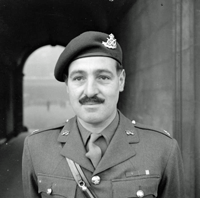
Citation
War Office, 2nd November, 1944.
The KING has been graciously pleased to approve awards of the VICTORIA CROSS to: —
Captain (temporary Major) Robert Henry Cain (129484), The Royal Northumberland Fusiliers, (attd. The South Staffordshire Regiment) (I Airborne Division) (Salcombe, Devon).
In Holland on 19th September, 1944, Major Cain was commanding a rifle company of the South Staffordshire Regiment during the Battle of Arnhem when his company was cut off from the rest of the battalion and during the next six days was closely engaged with enemy tanks, self-propelled guns and infantry. The Germans made repeated attempts to break into the company position by infiltration and had they succeeded in doing so the whole situation of the Airborne Troops would have been jeopardised.
Major Cain, by his outstanding devotion to duty and remarkable powers of leadership, was to a large extent personally responsible for saving a vital sector from falling into the hands of the enemy.
On 20th September a Tiger tank approached the area held by his company and Major Cain went out alone to deal with it armed with a Piat. Taking up a position he held his fire until the tank was only 20 yards away when he opened up. The tank immediately halted and turned its guns on him, shooting away a corner of the house near where this officer was lying. Although wounded by machine gun bullets and falling masonry, Major Cain continued firing until he had scored several direct hits, immobilised the tank and supervised the bringing up of a 75 mm. howitzer which completely destroyed it. Only then would he consent to have his wounds dressed.
In the next morning this officer drove off three more tanks by the fearless use of his Piat, on each occasion leaving cover and taking up position in open ground with complete disregard for his personal safety.
During the following days, Major Cain was everywhere where danger threatened, moving amongst his men and encouraging them by his fearless example to hold out. He refused rest and medical attention in spite of the fact that his hearing had been seriously impaired because of a perforated eardrum and he was suffering from multiple wounds.
On 25 September the enemy made a concerted attack on Major Cain's position, using self-propelled guns, flame throwers and infantry. By this time the last Piat had been put out of action and Major Cain was armed with only a light 2" mortar. However, by a skilful use of this weapon and his daring leadership of the few men still under his command, he completely demoralized the enemy who, after an engagement lasting more than three hours, withdrew in disorder.
Throughout the whole course of the Battle of Arnhem, Major Cain showed superb gallantry. His powers of endurance and leadership were the admiration of all his fellow officers and stories of his valour were being constantly exchanged amongst the troops. His coolness and courage under incessant fire could not be surpassed.
Read more
|
|
| |
|
Lance-Sergeant John Daniel Baskeyfield VC, The South Staffordshire- Regiment (1st Airborne Division)

Citation
War Office, 23rd November, 1944.
The KING has been graciously pleased to approve the posthumous award of the VICTORIA CROSS to: –
No. 5057916 Lance-Sergeant John Daniel Baskeyfield, The South Staffordshire- Regiment (1st Airborne Division) (Stoke-on-Trent).
On 20 September 1944, during the battle of Arnhem, Lance-Sergeant Baskeyfield was the N.C.O. in charge of a 6-pounder anti-tank gun at Oosterbeek. The enemy developed a major attack on this sector with infantry, tanks and self-propelled guns with the obvious intent to break into and overrun the Battalion position. During the early stage of the action the crew commanded by this N.C.O. was responsible for the destruction of two Tiger tanks and at least one self propelled gun, thanks to the coolness and daring of this N.C.O., who, with complete disregard for his own safety, allowed each tank to come well within 100 yards of his gun before opening fire.
In the course of this preliminary engagement Lance-Sergeant Baskeyfield was badly wounded in the leg and the remainder of his crew were either killed or badly wounded. During the brief respite after this engagement Lance-Sergeant Baskeyfield refused to be carried to the Regimental Aid Post and spent his time attending to his gun and shouting encouragement to his comrades in neighbouring trenches.
After a short interval the enemy renewed the attack with even greater ferocity than before, under cover of intense mortar and shell fire. Manning his gun quite alone Lance-Sergeant Baskeyfield continued to fire round after round at the enemy until his gun was put out of action. By this time his activity was the main factor in keeping the enemy tanks at bay. The fact that the surviving men in his vicinity were held together and kept in action was undoubtedly due to his magnificent example and outstanding courage. Time after time enemy attacks were launched and driven off. Finally, when his gun was knocked out, Lance-Sergeant Baskeyfield crawled under intense enemy fire to another 6-pounder gun nearby, the crew of which had been killed, and proceeded to man it single-handed. With this gun he engaged an enemy self propelled gun which was approaching to attack. Another soldier crawled across the open ground to assist him but was killed almost at once. Lance-Sergeant Baskeyfield succeeded in firing two rounds at the self propelled gun, scoring one direct hit which rendered it ineffective. Whilst preparing to fire a third shot, however, he was killed by a shell from a supporting enemy tank.
The superb gallantry of this N.C.O. is beyond praise. During the remaining days at Arnhem stories of his valour were a constant inspiration to all ranks. He spurned danger, ignored pain and, by his supreme fighting spirit, infected all who witnessed his conduct with the same aggressiveness and dogged devotion to duty which characterised his actions throughout.
Read more
|
|
| |
|
![[ Back to the Para's home page ]](Home-Page.gif)
|
|
| |
|
|
|
![[ Cap Badge ]](Wings.gif)
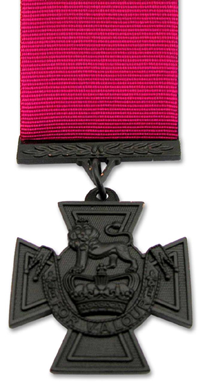
![[ 2 Para ]](CapbadgePara1.gif)
![[ 2 Para ]](CapbadgePara2.gif)
![[ 3 Para ]](CapbadgePara3.gif)
